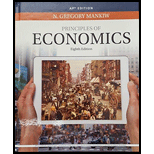
The percentage of income earned by poor and rich in the US.
Answer to Problem 1CQQ
Option 'b' is correct.
Explanation of Solution
Option (b):
Poverty line is the line that determines the minimum income required to meet the basic requirements of a quality life by the people. The household with family income less than the poverty line is said to be poor and those who earn very much above the poverty line are considered to be rich by the government. According to the available data about the US economy, the income distribution is very unequal. About the poorest, one-fifth of the total population earns about 4 percent of the income of the economy, whereas the top one-fifth of the rich population earns about 50 percent of the US total economy income today according to the sources.
From the reliable sources, it is obtained that about 4 percent of the total income is earned by the poorest fifth of the population and about 50 percent of the total income is earned by the richest fifth of the population. Since option 'b' gives the values equal to the obtained value, option 'b' is correct.
Option (a):
The data sources reveal that about 4 percent of the income of the US economy is earned by the poorest fifth of the economy, while 50 percent by the richest fifth. Since the option explains that the richest fifth of the economy earns 70 percent and the poorest fifth earns 2 percent which are incorrect to the obtained values, option 'a' incorrect.
Option (c):
The data sources reveal that about 4 percent of the income of the US economy is earned by the poorest fifth of the economy, while 50 percent by the richest fifth. Since the option explains that the richest fifth of the economy earns 35 percent and the poorest fifth earns 6 percent which are incorrect to the obtained values, option 'c' is incorrect.
Option (d):
The data sources reveal that about 4 percent of the income of the US economy is earned by the poorest fifth of the economy, while 50 percent by the richest fifth. This means that there is a high level of inequality in the distribution of income that exists in the economy. Since the option explains that the richest fifth of the economy earns 25 percent and the poorest fifth earns 8 percent which denotes lower levels of inequality in income distribution, they are incorrect to the obtained values, and thus option 'd' is incorrect.
Concept introduction:
Income inequality: Income inequality represents the unequal distribution of household or individual income among various economic participants of the society.
Want to see more full solutions like this?
Chapter 20 Solutions
Principles Of Economics, Ap Edition, 9781337292603, 1337292605, 2018
- how commond economies relate to principle Of Economics ?arrow_forwardCritically analyse the five (5) characteristics of Ubuntu and provide examples of how they apply to the National Health Insurance (NHI) in South Africa.arrow_forwardCritically analyse the five (5) characteristics of Ubuntu and provide examples of how they apply to the National Health Insurance (NHI) in South Africa.arrow_forward
- Outline the nine (9) consumer rights as specified in the Consumer Rights Act in South Africa.arrow_forwardIn what ways could you show the attractiveness of Philippines in the form of videos/campaigns to foreign investors? Cite 10 examples.arrow_forwardExplain the following terms and provide an example for each term: • Corruption • Fraud • Briberyarrow_forward
- In what ways could you show the attractiveness of a country in the form of videos/campaigns?arrow_forwardWith the VBS scenario in mind, debate with your own words the view that stakeholders are the primary reason why business ethics must be implemented.arrow_forwardThe unethical decisions taken by the VBS management affected the lives of many of their clients who trusted their business and services You are appointed as an ethics officer at Tyme Bank. Advise the management regarding the role of legislation in South Africa in providing the legal framework for business operations.arrow_forward
- Tyme Bank is a developing bank in South Africa and could potentially encounter challenges similar to those faced by VBS in the future. Explain five (5) benefits of applying business ethics at Tyme Bank to prevent similar ethical scandals.arrow_forward1.3. Explain the five (5) ethical challenges that can be associated with the implementation of the National Health Insurance (NHI) in South Africa.arrow_forward1.2. Fourie (2018:211) suggests that Ubuntu emphasises the willingness to share and participate in a community. However, it does not privilege the community over the dignity and life of the individual. With the above in mind, discuss how the implementation of the National Health Insurance (NHI) is a way to uphold the concept of Ubuntu.arrow_forward
 Principles of Economics (MindTap Course List)EconomicsISBN:9781305585126Author:N. Gregory MankiwPublisher:Cengage Learning
Principles of Economics (MindTap Course List)EconomicsISBN:9781305585126Author:N. Gregory MankiwPublisher:Cengage Learning Principles of Microeconomics (MindTap Course List)EconomicsISBN:9781305971493Author:N. Gregory MankiwPublisher:Cengage Learning
Principles of Microeconomics (MindTap Course List)EconomicsISBN:9781305971493Author:N. Gregory MankiwPublisher:Cengage Learning Principles of Economics, 7th Edition (MindTap Cou...EconomicsISBN:9781285165875Author:N. Gregory MankiwPublisher:Cengage Learning
Principles of Economics, 7th Edition (MindTap Cou...EconomicsISBN:9781285165875Author:N. Gregory MankiwPublisher:Cengage Learning Principles of MicroeconomicsEconomicsISBN:9781305156050Author:N. Gregory MankiwPublisher:Cengage Learning
Principles of MicroeconomicsEconomicsISBN:9781305156050Author:N. Gregory MankiwPublisher:Cengage Learning






